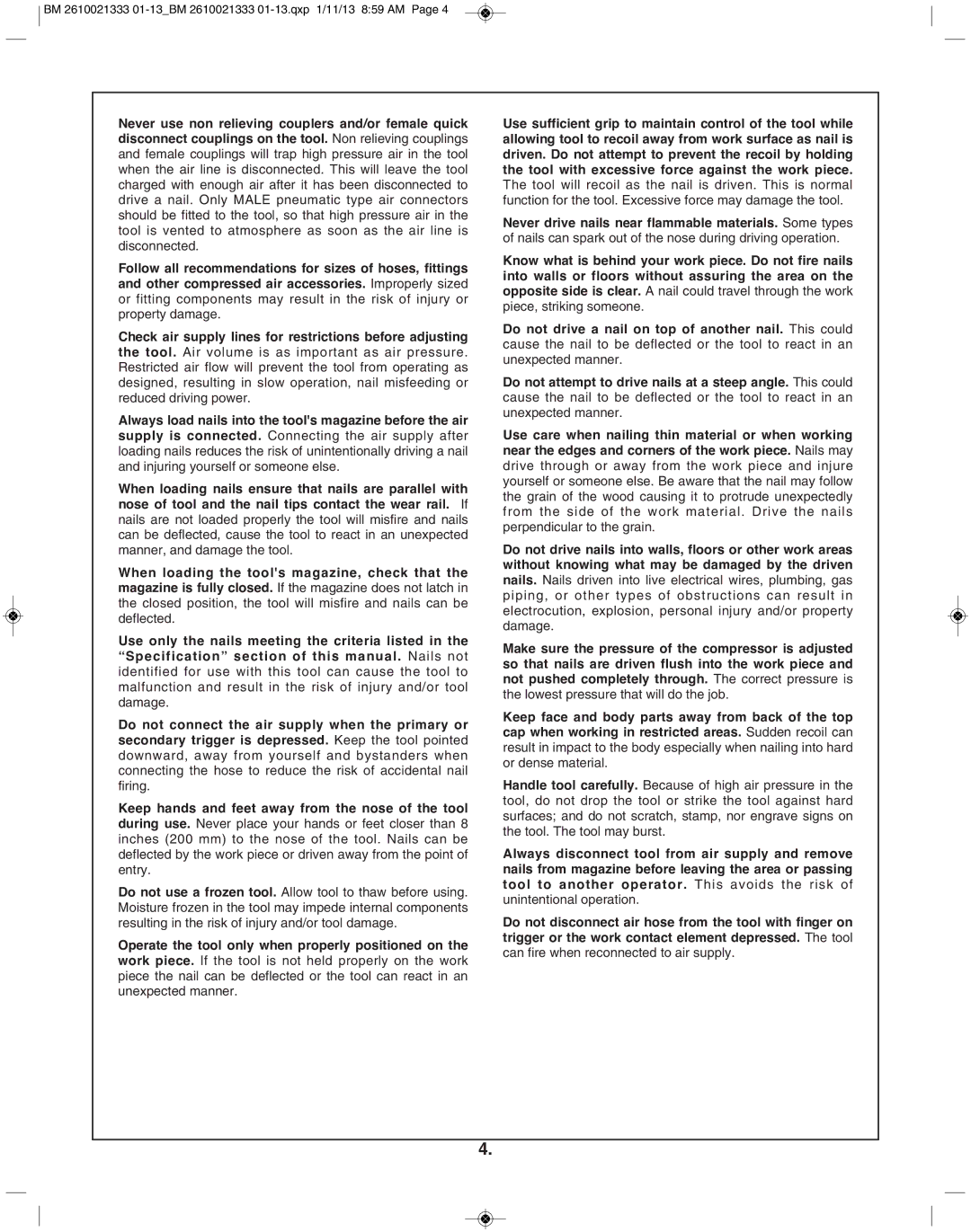
![]() BM 2610021333
BM 2610021333
Never use non relieving couplers and/or female quick disconnect couplings on the tool. Non relieving couplings and female couplings will trap high pressure air in the tool when the air line is disconnected. This will leave the tool charged with enough air after it has been disconnected to drive a nail. Only MALE pneumatic type air connectors should be fitted to the tool, so that high pressure air in the tool is vented to atmosphere as soon as the air line is disconnected.
Follow all recommendations for sizes of hoses, fittings and other compressed air accessories. Improperly sized or fitting components may result in the risk of injury or property damage.
Check air supply lines for restrictions before adjusting the tool. Air volume is as important as air pressure. Restricted air flow will prevent the tool from operating as designed, resulting in slow operation, nail misfeeding or reduced driving power.
Always load nails into the tool's magazine before the air supply is connected. Connecting the air supply after loading nails reduces the risk of unintentionally driving a nail and injuring yourself or someone else.
When loading nails ensure that nails are parallel with nose of tool and the nail tips contact the wear rail. If nails are not loaded properly the tool will misfire and nails can be deflected, cause the tool to react in an unexpected manner, and damage the tool.
When loading the tool's magazine, check that the magazine is fully closed. If the magazine does not latch in the closed position, the tool will misfire and nails can be deflected.
Use only the nails meeting the criteria listed in the “Specification” section of this manual. Nails not identified for use with this tool can cause the tool to malfunction and result in the risk of injury and/or tool damage.
Do not connect the air supply when the primary or secondary trigger is depressed. Keep the tool pointed downward, away from yourself and bystanders when connecting the hose to reduce the risk of accidental nail firing.
Keep hands and feet away from the nose of the tool during use. Never place your hands or feet closer than 8 inches (200 mm) to the nose of the tool. Nails can be deflected by the work piece or driven away from the point of entry.
Do not use a frozen tool. Allow tool to thaw before using. Moisture frozen in the tool may impede internal components resulting in the risk of injury and/or tool damage.
Operate the tool only when properly positioned on the work piece. If the tool is not held properly on the work piece the nail can be deflected or the tool can react in an unexpected manner.
Use sufficient grip to maintain control of the tool while allowing tool to recoil away from work surface as nail is driven. Do not attempt to prevent the recoil by holding the tool with excessive force against the work piece.
The tool will recoil as the nail is driven. This is normal function for the tool. Excessive force may damage the tool.
Never drive nails near flammable materials. Some types of nails can spark out of the nose during driving operation.
Know what is behind your work piece. Do not fire nails into walls or floors without assuring the area on the opposite side is clear. A nail could travel through the work piece, striking someone.
Do not drive a nail on top of another nail. This could cause the nail to be deflected or the tool to react in an unexpected manner.
Do not attempt to drive nails at a steep angle. This could cause the nail to be deflected or the tool to react in an unexpected manner.
Use care when nailing thin material or when working near the edges and corners of the work piece. Nails may drive through or away from the work piece and injure yourself or someone else. Be aware that the nail may follow the grain of the wood causing it to protrude unexpectedly from the side of the work material. Drive the nails perpendicular to the grain.
Do not drive nails into walls, floors or other work areas without knowing what may be damaged by the driven nails. Nails driven into live electrical wires, plumbing, gas piping, or other types of obstructions can result in electrocution, explosion, personal injury and/or property damage.
Make sure the pressure of the compressor is adjusted so that nails are driven flush into the work piece and not pushed completely through. The correct pressure is the lowest pressure that will do the job.
Keep face and body parts away from back of the top cap when working in restricted areas. Sudden recoil can result in impact to the body especially when nailing into hard or dense material.
Handle tool carefully. Because of high air pressure in the tool, do not drop the tool or strike the tool against hard surfaces; and do not scratch, stamp, nor engrave signs on the tool. The tool may burst.
Always disconnect tool from air supply and remove nails from magazine before leaving the area or passing tool to another operator. This avoids the risk of
unintentional operation.
Do not disconnect air hose from the tool with finger on trigger or the work contact element depressed. The tool can fire when reconnected to air supply.
4.
